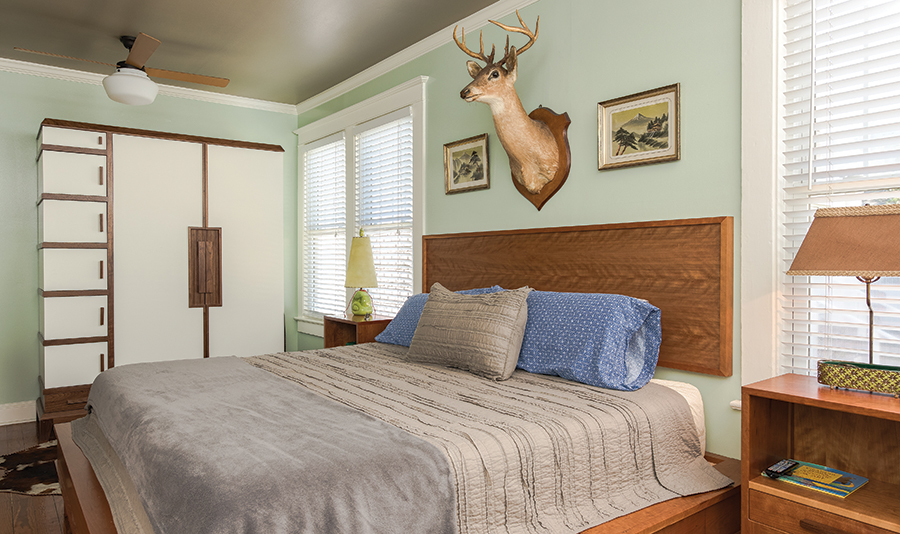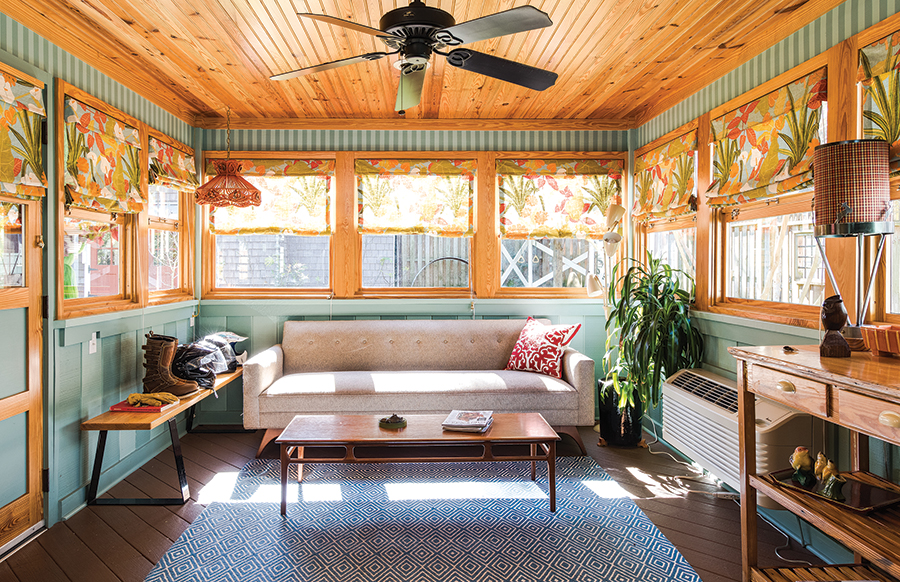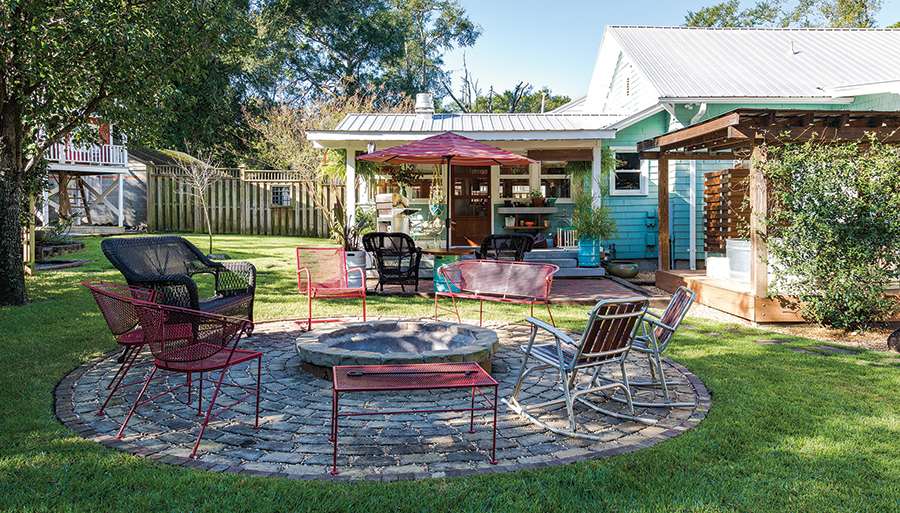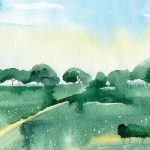Beneath the spreading live oaks of Wilmington’s eclectic first suburb, a remarkable bungalow speaks the language of its imaginative owner whose work is never finished
By Isabel Zermani
Photographs by Rick Ricozzi
On a storybook street in Sunset Park sits the 1919 Craftsman bungalow of Dusty Ricks, designer and neighborhood bar owner of Greenfield Street’s hotspot, Satellite. Sunset Park (est. 1912) was once a satellite of its own, Wilmington’s first suburb, built outside city limits, boasting of “artisanal water,” a river boating wharf and swimming at Greenfield Lake — perhaps there were no alligators then. The electric streetcar shuttled businessmen to and fro.
The poem “Sunset Park,” published in the Evening Dispatch, 1912, reads:
“Each man who owns a cottage / That he can call his own,
Will be a little Monarch / That no one can dethrone.”

Waylaid by war and industry, lots along “Riverside Drive,” the planned riverfront park and wharf with its sunset views, were sold instead to shipbuilding companies kept busy by one war after another. Sunset Park never blossomed as intended into anything approaching Atlanta’s elite Ansley Park. Small cottages for shipbuilders populated the available lots in the 1940s–60s.
Now, a working-class neighborhood with tree-lined promenades where inventive people homestead, Sunset Park is a bit checkered. But perhaps it is more accurate to think of chess instead, not all pawns, but a variety of pieces: the Queen Annes at the entrance on Central Boulevard; the Tudor revivals, the bishops; Ricks’ house, his castle; his motorcycle workshop out back, the knights. Now on the National Register of Historic Places, the eclectic suburb’s chief asset is its variety of 20th century styles.
The enormous live oak trees in Ricks’ front yard on Northern Boulevard snake in and out of the ground like a Chinese dragon. A picket fence and a pergola welcome passersby into the corner lot. Ferns and banana trees enliven the porch in the shade of sea-blue shakes. Another moniker for the craftsman is the “California bungalow.” Wilmington is called the California of the Carolinas; some surfboards would definitely not be out of place.
True to the Arts and Crafts era of the house, inside glows with the warming presence of wood. The movement’s simplicity can be shouted over or upstaged, but the harmony of clean lines and definitive forms is evergreen. A wall color palate ranging from dusty gray to brown to pistachio-green flows throughout the house, subtly changing the mood of each room. The brightest blues belong to the fireplace bricks, color-blocked like a Mondrian. Ricks skillfully brings vitality with a pop of color. The pleasure of a small surprise or an odd object has a resonate effect.
Elements of the decor hint at a mountain lodge, namely, taxidermy. Deer, ram, armadillo, nary a room is without a friend. Ricks does not hunt and admittedly carries spiders outside rather than dispatching them on the spot but, “I’ve always loved taxidermy.” A favorite are the gun racks for his grandfather’s rifles — “a tribute to him” — fashioned from upturned hooves.
In the master bedroom, the custom walnut wardrobe is a sight to behold. Masculine and pretty, each drawer swings open like a glove box. Function married to form, there are “no storage spaces (in this house)” says Ricks with a laugh. The platform bed, also by local artisan Stephane Bossut, veers more mid-century modern with its pared down, rectilinear form.
Guided by both 20th century design movements via an intuitive compass, Ricks heralds, “The clean lines. The colors. The simplicity of the designs.” And function. “Anything I make or repurpose is always with functionality in mind,” says Ricks. “For the most part, I’ve done everything myself.”
He doesn’t call himself a designer, but when someone conceives, creates and constructs something (a house, a bar, a hot tub) of their own imagination to very specific aesthetic desires. . . no other name will do. Self-taught and obsessive, Ricks’ design goals manifest in each room, each piece of furniture. He built the guest bath around an existing chimney and hunted down the rare “shorty” clawfoot tub in a stranger’s backyard. For his young son’s room, he repurposed an old medical cabinet to display books and toys. The living room buffet is a wood-topped Snap-On tool cabinet powder-coated a nostalgic milky green. The newly coated surface softens the industrial look, keeping the vintage appeal without looking aged. Ditto for the red wall of lockers.

Fifteen years into this house, he’s “never finished.” He finds joy in the doing, but his hands can’t keep up with his mind. “I have all these ideas floating around in my head all the time,” he explains. “It might be two years, it might be five years, it might be tomorrow that I do it. (The ideas) are just kind of there.” Some nights he stays in the barn — his workshop out back — “past 10 p.m.” but the tenor in his voice says he’s still facing a backlog.
For instance, he likes to make art lamps. He wouldn’t call himself an artist, but he’s “always wanted to have an art show.” His first lamp, made at age 22, has cartoons on the shade and a cage body encircling a steel chain, speaking to the purview of boys and men. He shows photos of other lamps, like a backlit rabbit head of hammered steel.
“Lighting is key for drawing people’s eyes where you want them to look,” says Ricks, master of misdirection, “especially in the bar, playing off the ceilings.”
In his home, an understated pendant lamp draws people around the dining table, a German biergarten he altered for year-round use. Unencumbered by chair backs — no scooting necessary — the picnic-style setting speaks to the indoor-outdoor lifestyle customary of mid-century modern. But the era that launched patio furniture, casual clothing and backyard BBQs is best embodied by the nearby sunroom.
Past the sunny kitchenette, pocket doors reveal the epicenter of Hollywood East relaxation: all windows, tropical Roman shades, a gleaming wood plank ceiling — one could drink a Singapore Sling while the custom hot tub, a galvanized livestock watering trough, comes to temperature. It won’t take long; it’s boiling hot, as is the outdoor shower. “I haven’t taken a shower in the house since I built that thing,” Ricks says with a laugh.
Filling out the entertaining space are turquoise kegs-turned-planters, a fire pit, a lawn to brag about, macramé plant holders and Eames-style bucket seats. “Some guy gave me a city bus,” say Ricks, a 1966 General Motors bus that drove the Sunset Park route, Transit bus 4312. The trifecta of history, form, function makes the bus one of Ricks’ favorite things to repurpose. The seats appear at the bar, too, with school desk additions Ricks made.
The bus also prompts the story of how he got into the bar business. Half of it he made into the DJ booth at Odessa (renamed Sputnik), the former downtown nightclub. He designed and built the other still-popular club, Pravda, with his sister and brother-in-law.
Ricks grew up on the outskirts of Clinton, North Carolina, to hardworking parents who “didn’t have a lot of money” but did create “the prettiest house in the neighborhood — still,” he reports. So, he comes by it honestly. He didn’t go to art school, though he would’ve liked to, but did open a skate shop when he was 22 years old. “It failed, but it was a learning experience.” He got a steady job “climbing poles” as a lineman with Progress Energy for a decade before Pravda and Odessa. But what he really wanted was a neighborhood bar: “a nice beer selection. A lodge-y, lived-in feel.” A clean dive bar.
And, with Satellite, he got it.

There just wasn’t much of a neighborhood on Greenfield Street in 2009. Newcomers to town may not remember the boarded-up, 13-acre, gray housing-project-turned-ghost-town, Nesbitt Courts, or the boarded-up drive-thru on 3rd Street with its iconic sign: “CHIK N’ FISH.” The former is now the hipster paradise complex South Front; LEED Silver, rooftop garden and saltwater pool, and the latter the Irish pub The Harp.
Ricks spotted a “for lease” sign on a defunct “stab n’ grab” in a stand-alone brick building that had been Lewis Groceries in 1940. He saw the space’s potential and went for it. The undesirable area made the price right, but “people thought I was batshit crazy,” remembers Ricks.
He stripped it, but kept the “pretty bones,” showing off the exposed brick and beams. “It was already building itself,” he says of the design process, “what it wanted to look like.” Like the stone speaking to a sculptor, the bar was borne in six months, opening Dec. 26, when people needed it most, decompressing from Christmas.
Unbeknown to Ricks, South Front would shortly begin development, but wouldn’t move in a customer base for two more years — plenty of time to fail — but for the nearby and crosstown drinkers alike who flocked to sip Satellite’s atmosphere. Embraced by the community, Satellite has since hosted “baby showers, weddings, wrap parties, FBI retirement parties.”
Inside Satellite, enormous garage-sized doorways open on the flank. Single Edison lightbulbs dangle over the reclaimed-wood counter set with stools more soda shop than barfly. A standing taxidermy bear and oil paintings of ships recall a curiosities shop. Sealed concrete floors add that biker flavor — café racers, not Harleys. Like his home, Ricks melds influences to create his unique look, proving the American craftsman, though he wouldn’t call himself that, is alive.
Nowadays, construction on Greenfield Street is nonstop. Industrial buildings are being retrofitted for housing. Satellite is expanding too; up next — a taqueria. One hopes the revitalization will spread a mile south to residential Sunset Park, where some people, do-it-yourself-ers like Ricks, are ahead of the trend.


